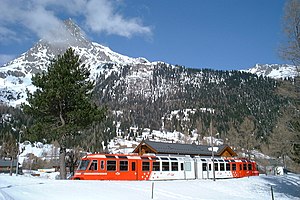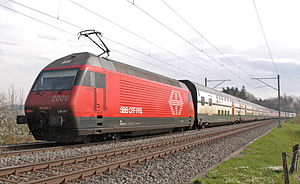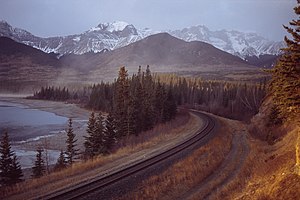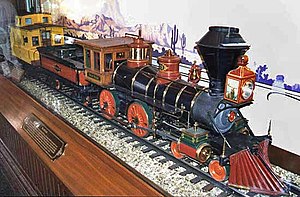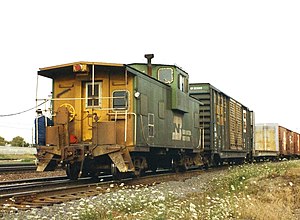Portal:Trains/Selected picture/2006 archive
This is an archive of images that have appeared in the Featured picture section of Portal:Trains in 2006. The portal went live on May 17, 2005, so Week 20, 2005, is the first entry.
A pedestrian tunnel at Kings Cross railway station.
King's Cross station is a railway station in the Kings Cross district of north east central London, located in the London Borough of Camden. King's Cross was originally designed and built as the London hub of the Great Northern Railway and terminus of the East Coast Main Line.
Recently featured: Snowdon Mountain Railway - Sacramento Regional Transit District - Bristol Temple Meads station
Week 2: January 8-January 14
Double slip switches at Munich's Central station
A railroad switch (known in British and Australian English as a set of points or, in technical usage, a turnout) is a mechanical installation provided at a point where a rail track divides into two tracks. A double slip, is a crossing of railroads at a small angle, with the possibility of vehicles being made to pass from one route to the other.
Recently featured: King's Cross station - Snowdon Mountain Railway - Sacramento Regional Transit District
Week 3: January 15-January 21
Tobu Railway types (from left to right) 1800, 350 and 300, 1800.
Tobu Railway (東武鉄道) is a commuter railway company in the Greater Tokyo Area of Japan as well as an intercity and regional operator running in Tokyo, Saitama, Chiba, Tochigi, and Gunma Prefectures. It offered freight service until September 30, 2003. The name of "Tobu" is from the acronym of '東' (Tō east) and '武' (bu of '武蔵' for Musashi Province), the initial area its network started.
Recently featured: double slip switches - King's Cross station - Snowdon Mountain Railway
Week 4: January 22-January 28
A Virgin trains Pendolino running on the West Coast Main Line alongside the M1 motorway near Daventry in Northamptonshire, England, close to the Watford Gap.
The West Coast Main Line (WCML) is one of the most important intercity railway lines in the United Kingdom, part of the British railway system. It begins at Euston station in London, links several of the UK's largest cities including Northampton, Birmingham, Manchester and Liverpool, and ends 400 miles north-west at Central station in Glasgow.
Recently featured: Tobu Railway - double slip switches - King's Cross station
Week 5: January 29-February 4
Percy the Small Engine, an 0-4-0 tank locomotive, from the Thomas the Tank Engine and Friends series, 14 August 2005 at Llangollen station during a "Days Out With Thomas" event on the Langollen Steam Railway.
Percy lives on the (fictitious) Island of Sodor with many other locomotives, including Thomas the Tank Engine, Gordon the Big Engine and Henry the Green Engine. He is the smallest and youngest of the principal steam engine characters, and also probably the cheekiest. The "Days Out With Thomas" events at heritage railways like Llangollen (a name which includes two voiceless alveolar lateral fricatives) help introduce railway history to a new generation of railfans.
Recently featured: West Coast Main Line - Tobu Railway - double slip switches
Week 6: February 5-February 11
Sir Nigel Gresley seen departing Goathland with a train for Pickering in 2001.
London and North Eastern Railway (LNER) A4 Class number 4498 Sir Nigel Gresley is a preserved British steam locomotive. It was the 100th Gresley 4-6-2 built, and it is the holder of the post-World War II world speed record for steam locomotives, 112 mph (180 km/h).
Recently featured: Percy the Small Engine - West Coast Main Line - Tobu Railway
Week 7: February 12-February 18
The interlocking mechanism in Deval Tower at Des Plaines, Illinois.
In mechanical interlocking plants, a locking bed is constructed, consisting of steel bars forming a grid. The control levers that operate switches, derails, signals or other appliances are connected to the bars running in one direction. The bars are constructed so that, if the function controlled by a given lever conflicts with that controlled by another lever, mechanical interference is set up in the cross locking between the two bars, in turn preventing the conflicting lever movement from being made.
Recently featured: Sir Nigel Gresley - Percy the Small Engine - West Coast Main Line
Week 8: February 19-February 25
Looking down from the top of the Bridgnorth Cliff Railway in 2004.
The Bridgnorth Cliff Railway links the High Town and Low Town areas of Bridgnorth. The track length is 201 ft (61.2 metres), with a gradient of 1 in 1.8 and a rise of 111 ft (33.8 metres) at an angle of 33 degrees. It is one of the steepest railways in England, and at least one source (the information panel outside the top station) claims it is both the steepest and shortest.
Recently selected: Interlocking mechanism - Sir Nigel Gresley - Percy the Small Engine
Week 9: February 26-March 4
WD Austerity 2-10-0 Λβ-964 preserved in operational condition Greece.
The British War Department (WD) "Austerity" 2-10-0 is a class of heavy freight steam locomotive that was introduced in 1943. The class featured a parallel boiler and round-topped firebox. They were the first 2-10-0 locomotives to work in Great Britain, and the first major class of ten-coupled engines. After World War II, the class was distributed among railroads of Great Britain, the Netherlands, Greece, and Syria.
Recently selected: Bridgnorth Cliff Railway - Interlocking mechanism - Sir Nigel Gresley
A Great Orme Tramway car nears the Great Orme summit.
The Great Orme Tramway (Welsh: Tramffordd y Gogarth) is a cable-driven 3 ft 6 in (1066 mm) gauge tramway in Llandudno in north Wales. It is Great Britain's only remaining cable operated street tramway and one of only three surviving in the world. Operation of the tramway differs from the famous and unique San Francisco system in that it is a street funicular, where the cars are permanently fixed to the cable and are stopped and started by stopping and starting the cable.
Recently selected: WD Austerity 2-10-0 - Bridgnorth Cliff Railway - Interlocking mechanism
narrow gauge 0-4-2ST locomotive Blanche, formerly of the Penrhyn Quarry, operating on the Ffestiniog Railway
Narrow-gauge railways are railroads (railways) where the distance between the two parallel rails constituting the railway track (the track gauge) is less than the 1,435 mm (4 ft 8+1⁄2 in) of standard gauge railroads. The rationale for the use of a narrower gauge is that a railway using such a gauge can be substantially cheaper to build, equip, and operate than one built to standard gauge. On the other hand, standard gauge railroads have a greater haulage capacity and allow greater speeds than those a narrow gauge system can attain.
Recently featured: Great Orme Tramway - WD Austerity 2-10-0 - Bridgnorth Cliff Railway
Lisbon's "elevador" (funicular) of Bica descending the hill and entering the arrival tunnel
A funicular, also called an inclined railway, inclined plane, or, in the United Kingdom, a cliff railway, is a system of transport in which cables attached to a tram-like vehicle on rails move it up and down a very steep slope. The word "funicular" derives from the Latin funiculus (thin rope), a diminutive of funis (rope).
Recently featured: Ffestiniog Railway's Blanche - Great Orme Tramway - WD Austerity 2-10-0
A train on the high bridge at the Georgetown Loop, circa 1885.
The Georgetown Loop is a narrow gauge heritage railway located in Clear Creek County, Colorado in the United States. It runs for four miles (6.4 km) between the historic mining towns of Georgetown and Silver Plume in the upper canyon of Clear Creek west of Denver. Originally part of the larger line of Colorado Central Railroad constructed in the 1870s and 1880s, it was later dismantled, but was restored in the 1980s to operate during summer months as a tourist railroad.
Recently featured: Elevador da Bica - Ffestiniog Railway's Blanche - Great Orme Tramway
A Canadian National Railway (CN) train, led by a CN GE Dash 9-44CW and a CSX EMD SD40-2, crosses the North Thompson River near Kamloops, British Columbia.
The Canadian National Railway (CN; AAR reporting marks CN, CNA, CNIS) is a Canadian Class I railway operated by Canadian National Railway Company headquartered in Montreal, Quebec. It is the largest railway in Canada, in terms of both revenue and the physical size of its rail network. CN is currently Canada's only transcontinental railway company, spanning Canada from Nova Scotia to British Columbia. It also has extensive trackage in the central United States along the Mississippi River valley from the Great Lakes to the Gulf of Mexico. CN has expanded significantly in the United States, purchasing Illinois Central Railroad and Wisconsin Central Railway, among others. Now primarily a freight railway, CN also operated passenger services until 1978, when they were assumed by VIA Rail.
Recently featured: Georgetown Loop - Elevador da Bica - Ffestiniog Railway's Blanche
narrow gauge trams use temporary tracks on the ice crossing the Neva River in Saint Petersburg, Russia.
A tram (tramcar, trolley, streetcar, or street railway) is a railborne vehicle, lighter than a typical train, designed for the transport of passengers (and/or, very occasionally, freight) within, close to, or between villages, towns and/or cities. Trams are distinguishable from other forms of railborne vehicles in that they often travel wholly or partly along tracks laid down in streets, usually on track reserved for the tram system. Also, most tram systems lack platforms — riders simply step off the car.
Recently featured: Canadian National Railway - Georgetown Loop - Elevador da Bica
A fully assembled level junction ready to be installed.
In U.S. railroad practice, a level junction (or in the United Kingdom a flat junction) is a railway junction that has a track configuration in which merging or crossing railroad lines provide track connections with each other that require trains to cross over in front of opposing traffic at grade. The structure is sometimes called a diamond junction or diamond crossing in reference to the diamond-shaped center. Routings must be controlled by signals and an interlocking plant, or by an automated Centralized Traffic Control (CTC) system. The two tracks need not be of the same gauge.
Recently featured: Saint Petersburg trams - Canadian National Railway - Georgetown Loop
Mist rising from the Oulujoki river embraces the Vaalankurkku railway bridge near Vaala station on the VR Group railway in Finland.
VR or VR Group (VR-Yhtymä) is a state-owned railway company, formerly known as Valtionrautatiet, in Finland. Its most important function is the operation of freight and passenger rail services. Maintenance and construction of the railway network itself is the responsibility of the Finnish Rail Administration (Ratahallintokeskus - RHK). Both operation and network were originally handled by the parent company Valtionrautatiet, which split into the two current companies.
Recently featured: Level junction - Saint Petersburg trams - Canadian National Railway
Marousi station on Line 1 of the Athens Metro
The Athens Metro is the underground public transport system of Athens, Greece, constructed by the Attiko Metro (Αττικό Μετρό) company (literally 'Attican metro') and the ISAP company (Ilektrikoi Sidirodromoi Athinon-Pireos/Ηλεκτρικοί Σιδηρόδρομοι Αθηνών-Πειραιώς) (Athens Piraeus Electric Railways). Metro Line 1 was inaugurated on February 27, 1869, as a steam train line connecting Athens and Piraeus and was operated by Athens Piraeus Railway SA. The line was electrified in 1904 and the operating company renamed to Athens Piraeus Electric Railway SA in 1976. Today, Line 1 reaches the suburb of Kifisia and is also known as the green line and the electric railway.
Recently featured: VR Group bridge near Vaala - Level junction - Saint Petersburg trams
Various steam locomotives around the turntable at Barrow Hill Engine Shed.
Barrow Hill Engine Shed, until 1948 known as Staveley Engine Shed, is a former Midland Railway roundhouse in Barrow Hill, near Staveley and Chesterfield, Derbyshire (grid reference SK435747). Operational from 1870 to 1991, it was closed after a period of low usage. After becoming a listed building and following extensive renovation, the roundhouse and associated lines were re-opened in 1998 and are now are home to many preserved locomotives.
Recently featured: Athens Metro, Marousi station - VR Group bridge near Vaala - Level junction
Passenger Transport of China by Railway: a double-deck sleeping car on a modern train in the People's Republic of China. This is train number 5801 from Urumqi railway station to Alashankou railway station; the photo was taken at Bole railway station, where the train stops for 6 minutes.
Rail is one of the principal means of transport in Mainland China. Over 10 billion passenger railway journeys occur every year. Many of these journeys are taken during the Spring Festival Transportation period; in 2006 the railway system of Mainland China transported more than 1.44 billion people during the festival period.
Recently featured: Barrow Hill Engine Shed - Athens Metro, Marousi station - VR Group bridge near Vaala
Preserved GWR King Class No. 6024 King Edward I at Paignton on 31 July 2005.
The Great Western Railway (GWR) 6000 Class or King is a class of 4-6-0 steam locomotive designed for express passenger work. They were the largest locomotives the GWR built. They were named for kings of England, beginning with the reigning monarch, King George V, and going back through history (but with the final pair of engines later renamed for George V's sons, who succeeded him).
Recently featured: Passenger transport in China - Barrow Hill Engine Shed - Athens Metro, Marousi station
Sparks fly from the electrification system on the London Underground.
The London Underground uses a 4-rail system in which the electrical return is isolated from the running rails (the rails used by the train's wheels). Sparks like this are quite normal and occur when the electric power collection "shoes" of a train that is motoring (i.e. drawing power) reaches the end of a section of electric power rail.
Recently featured: GWR King class - Passenger transport in China - Barrow Hill Engine Shed
An InterCityExpress (ICE) train of Deutsche Bahn near Lonsee, in the Alb-Donau district of Baden-Württemberg, Germany.
The ICE is a type of high-speed train operated mostly by DB Fernverkehr in Germany and neighboring countries. The ICE originated in the 1973 InterCity network, which featured synchronized timetables with bi-hourly traffic on all lines. ICE established the world speed record for conventional trains on 1 May 1988 although it has since been surpassed by French TGV.
Recently featured: Sparks on the London Underground - GWR King class - Passenger transport in China
An electric multiple unit train on the Saint-Gervais-Vallorcine Line at Buet.
The Saint-Gervais-Vallorcine Line is a single track 36.5 km (22.7 mi) long metre gauge railway line in France connecting SNCF's Saint-Gervais-Le Fayet station with Vallorcine on the border with Switzerland. The line was opened in the 19th century by Chemins de fer de Paris à Lyon et à la Méditerranée.
Recently featured: ICE train near Lonsee - Sparks on the London Underground - GWR King class
A 9000 class train of the Keio Corporation.
Keio Corporation (京王電鉄株式会社, Keiō Dentetsu Kabushiki-gaisha) (TYO: 9008) is a private railway in Tokyo, Japan. It connects the western suburbs of the city (Chōfu, Fuchū, Hachiōji, Hino, Inagi, Sagamihara, Tama) with the city center at Shinjuku Station. It does not serve Tōkyō Station.
Recently featured: Saint-Gervais-Vallorcine Line - ICE train near Lonsee - Sparks on the London Underground
An SBB Re 460 class electric locomotive leading the IC 2000.
The IC 2000 is a double-decker passenger train in Switzerland and operated by Swiss Federal Railways. When it debuted in 1997, it was the first double-decker train in use on a nationwide scale. Previously, most double-decker trains, belonged to the Zürich S-Bahn network.
Recently featured: Keio Corporation - Saint-Gervais-Vallorcine Line - ICE train near Lonsee
A preserved Duluth, Missabe and Iron Range Railway 2-8-8-4 Yellowstone class steam locomotive in Two Harbors, Minnesota.
The Duluth, Missabe and Iron Range Railway (reporting mark DMIR) operated in northern Minnesota and Wisconsin to haul iron ore and later taconite to the Great Lakes ports of Duluth and Two Harbors, Minnesota. The railway was acquired on May 10, 2004, by Canadian National Railway (CN) when it purchased the assets of Great Lakes Transportation.
Recently featured: IC 2000 - Keio Corporation - Saint-Gervais-Vallorcine Line
Flinders Street Station, Melbourne, at the intersection of Swanston Street (running left-right) and Flinders Street (running diagonally top-bottom), in 1927.
Flinders Street Station is the central railway station of the suburban rail network of Melbourne, Australia. Each weekday, approximately 105,000 commuters and 1,500 trains pass through it. It is currently serviced by Connex's suburban and city loop services, and V/Line's regional services.
Recently selected: DM&IR 2-8-8-4 - IC 2000 - Keio Corporation
An RhB train crossing the Landwasser Viaduct.
RhB operates the largest network of all the private railways in Switzerland, over most of the railways in the south-easternmost canton of Graubünden.
Recently selected: Flinders Street Station - DM&IR 2-8-8-4 - IC 2000
Construction trains in the eastern tube of the Gotthard Base Tunnel, August 28, 2004.
The Gotthard Base Tunnel is a railway tunnel under construction in Switzerland. With a planned length of 57 km (35 miles) and a total of 153.5 km (95 mi) of tunnels, shafts and passages planned, it will be the longest railway tunnel in the world upon completion in 2015, ahead of the current longest, the Seikan Tunnel. The project is designed to feature two separate tunnels containing one track each.
Recently featured: RhB - Flinders Street Station - DM&IR 2-8-8-4
View from the rear platform of the Simskaia Station of the Samara-Zlatoust Railway, part of the Trans-Siberian Railway, Russia. This is a very early color photograph by Sergei Mikhailovich Prokudin-Gorskii, made in 1910 on three glass plates, one for each of the primary colors of red, green, and blue. Outfitted with a specially equipped railroad car darkroom provided by Tsar Nicholas II, and in possession of two permits that granted him access to restricted areas and cooperation from the empire's bureaucracy, Prokudin-Gorskii documented the Russian Empire around 1909 through 1915.
Recently featured: Gotthard Base Tunnel - RhB - Flinders Street Station
Canadian National Railway track along the Athabasca River at the mouth of Brule Lake in Alberta, Canada
Canadian National Railway (CN) is the largest railway in Canada, in terms of both revenue and the physical size of its rail network. CN is currently Canada's only transcontinental railway company, spanning Canada from Nova Scotia to British Columbia. It also has extensive trackage in the central United States along the Mississippi River valley from the Great Lakes to the Gulf of Mexico.
Recently featured: Simskaia Station - Gotthard Base Tunnel - RhB
A switchman on the Trans-Siberian railway near Ust-Katav in 1911.
The main route, of the Trans-Siberian, runs from Moscow to Vladivostok via southern Siberia and was built between 1891 and 1916. The Russian passenger train service on this route, at 9,288 kilometres (5,772 miles), spanning 8 time zones and taking about 7 days to complete its journey, is the third longest single continuous service in the world.
Recently featured: Canadian National Railway at Brule Lake - Simskaia Station - Gotthard Base Tunnel
A 1:8 scale live steam miniature railway at the Finnish Railway Museum in Hyvinkää.
The term live steam often refers to a model steam locomotive, or any other steam-operated model that is powered by steam produced by boiling water. Model scales can range from pocket-size to 1:2 scale. Ridable, large scale live steam railroading on a backyard railroad is an increasingly popular, but time-consuming and/or expensive hobby. Garden railways, in smaller scales, offer the excitement of real steam engines, but at lower cost, and in less space.
Recently featured: Trans-Siberian railway switchman in 1911 - Canadian National Railway at Brule Lake - Simskaia Station in 1910
Week 35: August 27-September 2
Former British Rail motive power stacked at Vic Berry's scrapyard.
Vic Berry's is a large, abandoned railway scrapyard in the Goods Yard and Engine Shed area of south central Leicester. Vic Berry's permanently closed for business in the 1990s after a stack of equipment similar to the one shown caught fire.
Recently featured: Live steam - Trains-Siberian railway switchman - Canadian National Railway at Brule Lake
Week 36: September 3-September 9
The Royal Train passing along the Dawlish sea front on September 15, 2004.
The Royal Train is the name given to the set of carriages dedicated for the use of the British Monarch, other members of the Royal Family, and their staff. The train currently consists of nine carriages, though not all will be used to form a train, as different vehicles have specified purposes. Two locomotives are nominated for use on the train, but are used for other traffic too. The carriages may only be used for other Heads of State; they cannot be hired by private users.
Recently selected: Vic Berry's scrapyard - Live steam - Trains-Siberian railway switchman
Week 37: September 10-September 16
A passenger train of the Matadi-Kinshasa Railway in operation.
The Matadi-Kinshasa Railway is a 366 kilometers (227 mi) long railway line in Bas-Congo between the port of Matadi and Kinshasa, the capital of Democratic Republic of the Congo. The railway was built from 1890 to 1898, and it is currently operated by ONATRA.
Recently selected: Royal Train - Vic Berry's scrapyard - Live steam
Week 38: September 17-September 23
Mount Fuji with a Shinkansen train and Sakura trees in the foreground.
The Shinkansen (Japanese: 新幹線) is a network of high-speed railway lines in Japan operated by Japan Railways. Since the initial Tōkaidō Shinkansen opened in 1964, the network has expanded to link most major cities on the islands of Honshū and Kyūshū with running speeds of up to 300 km/h (186 mph),
Recently featured: Matadi-Kinshasa Railway - Royal Train - Vic Berry's scrapyard
Week 39: September 24-September 30
The Savannahlander passing Stoney Creek Falls near Cairns.
The Savannahlander is a railmotor service that operates in Queensland, Australia. The train travels from the coastal town of Cairns to Forsayth. The service was once operated by Queensland Rail Traveltrain but is now run under contract by a private operator.
Recently featured: Shinkansen at Mt Fuji - Matadi-Kinshasa Railway - Royal Train
A train of the New York City Subway's C line at the 86th Street station.
86th Street is a local station at Central Park West and 86th Street. Both platforms are on the west side, northbound above southbound, and both express tracks are to the east in the same configuration. The C Eighth Avenue Local is a service of the New York City Subway. It is colored blue, since it uses the IND Eighth Avenue Line through Manhattan. The normal C service pattern is from 168th Street in Washington Heights, Manhattan, to Euclid Avenue in City Line, Brooklyn, running local in Manhattan and Brooklyn to complement the A.
Recently featured: The Savannahlander - Shinkansen at Mt Fuji - Matadi-Kinshasa Railway
Week 41: October 8-October 14
Walt Disney's Carolwood Pacific Railroad 1:8 scale, 7¼ inch (18.4 cm) gauge 4-4-0 locomotive Lilly Belle on display at Disneyland Main Station in 1993.
The Carolwood Pacific Railroad was a live steam backyard railroad, built by the American animated film producer and animator, Walt Disney (1901-1966) in the garden of the backyard of his home. Entertaining his daughters and their friends in his backyard and taking them for rides on his ½ mile (0.8 km)-long, 1:8 scale miniature railroad led Walt Disney to include the railroad which formed the backbone of his family-oriented Disneyland opened in Anaheim, California, in 1955.
Recently featured: 86th Street station, New York - The Savannahlander - Shinkansen at Mt Fuji
Week 42: October 15-October 21
A German Krupp K5 railway gun during World War II.
The Krupp K5 series all were consistent in mounting a 21.5 m (70.5 ft) long barrel in a box mounting. This mounting was then mounted on a pair of 12-wheel bogies designed to be operated on commercial and military rails built to German standards. K5 development began in 1934 with first testing following in 1936.
Recently selected: Lilly Belle - 86th Street station, New York - The Savannahlander
Week 43: October 22-October 28
The McCormick Tribune Campus Center station on Chicago 'L''s Green Line.
The Green Line (Lake-Englewood & Lake-Jackson Park Services) is a completely elevated route of the Chicago 'L' utilizing the system's oldest segments, extending 20.8 miles (33.5 km) with 29 stops between Forest Park and Oak Park, through Chicago's Loop, to the South Side and Englewood and Woodlawn.
Recently selected: Krupp K5 - Lilly Belle - 86th Street station, New York
Week 44: October 29-November 4
A British Rail Class 57/3, number 57303, Alan Tracy, leads a train at Bagillt, near Flint, on a Manchester to Holyhead service.
The British Rail Class 57/3 is a subclass of the British Rail Class 57 locomotives used by Virgin Trains. The Virgin fleet is painted in their red and silver livery, and locomotives are named after characters from the TV series "Thunderbirds".
Recently selected: Chicago 'L' Green Line - Krupp K5 - Lilly Belle
Week 45: November 5-November 11
A train of the Durango and Silverton Narrow Gauge Railroad in Colorado, United States.
The Durango and Silverton Narrow Gauge Railroad (D&SNG) is a narrow gauge heritage railway originally built between 1881 and 1882, by the Denver and Rio Grande Railroad, in order to carry silver and gold ore mined in the San Juan Mountains. The line from Durango to Silverton has run continuously since 1881, and is one of the few places in the United States which has seen continuous use of steam locomotives.
Recently selected: British Rail class 57/3 - Chicago 'L' Green Line - Krupp K5
Week 46: November 12-November 18
Rain, Steam and Speed - The Great Western Railway, an 1844 oil painting by J. M. W. Turner.
The painting depicts a train of the Great Western Railway crossing the River Thames on Brunel's recently completed Maidenhead Railway Bridge. The bridge, which still stands today, was built to carry two tracks of the then broad gauge railway.
Recently featured: Durango & Silverton Narrow Gauge Railroad - British Rail class 57/3 - Chicago 'L' Green Line
Week 47: November 19-November 25
A Burlington Northern Railroad caboose on a train entering Eola Yard, Aurora, Illinois, in 1993.
A caboose (US railway terminology) or brake van or guard's van (British terminology) is a manned rail transport vehicle coupled at the end of a freight train. Although cabooses were once used on nearly every freight train in North America, their use has declined and they are seldom seen on trains, except on locals and smaller railroads.
Recently selected: Rain, Steam and Speed - The Great Western Railway - Durango & Silverton Narrow Gauge Railroad - British Rail class 57/3
Week 48: November 26-December 2
Winter on the Mariazellerbahn in Austria; a regional train passes the Heugraben viaduct near Puchenstuben station.
The Mariazellerbahn ("Mariazell Railway") is an electrically operated narrow-gauge railway of the Österreichische Bundesbahnen with a track gauge of 760 mm (2 ft 5+15⁄16 in) ("Bosnian gauge") which connects the Lower Austrian capital Sankt Pölten with the Styrian pilgrimage centre of Mariazell.
Recently selected: Caboose - Rain, Steam and Speed - The Great Western Railway - Durango & Silverton Narrow Gauge Railroad
Week 49: December 3-December 9
A narrow gauge North Pacific Coast Railroad train derailed by the 1906 San Francisco earthquake in front of the Point Reyes Hotel.
Note the three link and pin coupler pockets on the locomotive pilot; this locomotive was equipped to shunt both narrow and standard gauge cars. In 1907 the North Pacific Coast Railroad was sold to the North Shore Railroad which soon became Northwestern Pacific Railroad.
Recently selected: Mariazellerbahn - Caboose - Rain, Steam and Speed - The Great Western Railway
Week 50: December 10-December 16
A large stockpile of 27,000 wheelsets (wheel and axle assemblies) in Siberia during World War I.
Wheelsets like these would be used in freight and passenger car bogies.
Recently selected: North Pacific Coast Railroad - Mariazellerbahn - Caboose
Week 51: December 17-December 23
A tunnel of the Copenhagen Metro, a rapid transit system serving Copenhagen and Frederiksberg, Denmark.
The metro's first line connecting Nørreport to Lergravsparken and Vestamager was opened by Queen Margrethe II on October 19, 2002. Since then the system has been extended to its present extent with plans to build a circle line to open in 2017.
Recently selected: Wheelsets in Siberia - North Pacific Coast Railroad - Mariazellerbahn
Week 52: December 24-December 30
A locomotive of the West Coast Wilderness Railway being turned on the turntable.
The West Coast Wilderness Railway is a reconstruction of the Mount Lyell Mining and Railway Company railway between Queenstown and Regatta Point, Tasmania.
Recently selected: Copenhagen Metro tunnel - Wheelsets in Siberia - North Pacific Coast Railroad
Week 53: December 31-January 6, 2007
Chicago and North Western Railway towerman R. W. Mayberry operates the retarders at Proviso Yard in Chicago, Illinois, May 1943.
Hump yards are the largest and most effective classification yards with the largest shunting capacity. The heart of these yards is the hump: a lead track on a hill (hump) over which the cars are pushed by the engine. Single cars, or some coupled cars in a block, are uncoupled just before or at the crest of the hump and roll by gravity into their destination tracks in the classification bowl (the tracks where the cars are sorted). They are slowed in their descent by retarders that grip the wheels of passing cars to slow them by friction.
Recently selected: West Coast Wilderness Railway - Copenhagen Metro tunnel - Wheelset stockpile


















